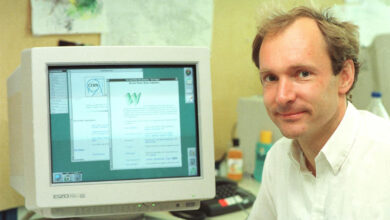
Podcast: Play in new window | Download
Originally conceived as a way for the United States armed forces to communicate with each other effectively, the precursor to the modern internet, ARPAnet, was a way for the military to quickly and effectively share critical information, regardless of where they were located. Amazingly, this network, which belonged to the Advanced Research Projects Agency, hence its name was the forerunner of the Internet and was created in 1969. Non-military members loved the effectiveness of the system and found ways to share information between their computers too, and so, it expanded.
ARPAnet developers came up with the TCP/IP concepts of how computers would talk to each other. The internet protocol, or IP, includes an addressing scheme or set of numbers that indicate a computer’s location. A later computer developer, Tim Berners-Lee, crafted the other languages and methods used by the current internet – HTTP (hypertext transfer protocol), URL (universal resource locator), and HTML (hypertext markup language) – and which would later allow the World Wide Web to be possible. Tim Berners-Lee and his colleagues devised all of these in the late 80s and early 90s at CERN in Geneva, making him essentially the father of the World Wide Web.
So who is Tim Berners-Lee? He hails from London and holds a degree in physics from Oxford University. Never content to sit back and wait for the next thing, despite creating one of the singular most important inventions of all time, he currently holds the title of director of the World Wide Web Consortium which continues to set technical standards for the Internet. During the late 80s and early 90s, he worked at CERN, a high energy physics lab, as a software engineer.
A logical next question is why did he take the time to create a way for computers to interact when his degree was in physics? The CERN institute welcomed scientists from around the world to come and experiment, but rarely did the scientists stay for any length of time. They would often conduct their experiments and go home again, yet they longed for ways of finding out what results other scientists got, as well as to share ideas.
The institute also had its share of frustrations in that each individual computer held the researcher’s data, but none of it was shared. There were sometimes different computer languages being used on each of those computers. Berners-Lee saw that communication between these different systems was important and therefore worth investing some time in.
The genesis of the Web was a series of programs Berners-Lee wrote that would clear up the communication differences within CERN. He kept tinkering and asking the question “What else can I do” until he had created the foundation of the Web.
Berners-Lee can thank Vinton Cerf for helping co-develop the World Wide Web and he can go back even further to Vannevar Bush who created the underlying structure of hypertext back in 1945. Fast forward to 1989 when Berners-Lee initially submitted his proposal to CERN. The first one was not accepted, but he tried again on November 12 1990. This time, his proposal was more specific, detailing the three languages and methods that became the foundation for nearly every webpage seen today. He also created the first server and the first web page.
What do those three languages and methods actually do, one might wonder. HTML is the structure that allows documents to be formatted properly and for hyperlinks to be able to function. A URL is the web address, and HTTP is the ability to retrieve a link from somewhere on the internet. It no longer has to be listed as the beginning of a web address, but for many years, every website had to begin with HTTP.
After Berners-Lee’s second proposal was accepted and implemented, the web started to grow almost immediately, branching outside of the CERN group by 1991. In 1993, the World Wide Web was becoming a truly worldwide phenomenon, and CERN decreed that the web would be available to anyone at no cost.
Twenty years on and the world cannot imagine a planet without the Web. It’s still very much a tool used only by the so-called First World, but that is what drives part of Berners-Lee’s continuing mission. He started the World Wide Web Consortium (W3C) in 1994 to ensure that there is a structure and a set of agreed-upon guidelines that will enable the world to have access to the web and all of the things that go with it. This means making sure that web pages will work with any language and allowing people with disabilities the chance to use the web as well.
The W3C now serves to keep the technologies developed by Berners-Lee free and attempts to bring more people online each year. So far, only about 25% of the world’s population is online – approximately 1.7 billion people.
Berners-Lee also created the Web Science Trust (WST) along with several other people. Its goal is to allow many disciplines to come together, experts like computer scientists, mathematicians, sociologists, and politicians so issues around the Web can be addressed and the Web can continue to grow and reach more individuals.
His lasting goal is to let the web continue to expand, inspire people, and foster understanding. As he stated in an interview once, “Let’s use the web to create neat new exciting things.” Given that the web itself is neat and exciting, it is interesting to hear him say he wishes for more, despite already earning his place in the history books.
Podcast: Play in new window | Download





